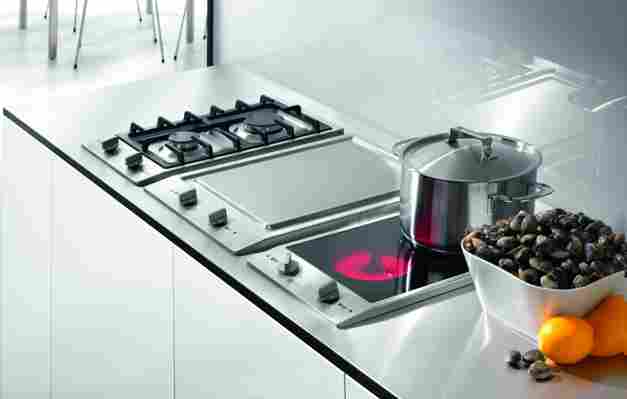If you don’t have a gas main available, are you willing to pay to set one up and go through the installation process?

Will your choice fit the current style and theme of your kitchen?
Do you have compatible pans for inductions stoves or are you will to purchase them?
How important is the ease of cleaning?
Do you always cook in a rush and don’t really have time to wait for an electric stove to heat up?
Do you have small children at home?
What is your budget for the actual appliance as well as the monthly cost you’ll incur for gas or electric bills?
Gas
Gas stovetops are generally present in older, traditional homes and some people still prefer it today as it instantly heats up when you turn it on as opposed to electric stoves. A lot of chefs prefer gas because you can easily gauge the amount of heat being emitted by the size of the flame, giving them precise control over their cooking. You can also use all types of cookware on a gas stovetop such as cast iron, stainless steel, and woks. Gas is also the cheaper option if you already have a gas line running in the kitchen. Some homes don’t, forcing you to either opt for an electric or induction stove, or paying the money to install bottled gas or run a connection to the gas mains.
The downside with gas stoves, however, is that they’re more prone to accidental fires, gas leaks or combustion. Make sure you have a carbon monoxide detector in your home if you have a gas stove. Considering the open flame, you’ll also need more ventilation as well as more distance between the stove, cupboards and exhaust fan. Gas stoves are also more difficult to clean as you’ll need to remove the grates from the stove, scrub them separately then clean the stove top itself. Parents with small children need to keep a careful eye on them when the stove is on.
A gas stove can work in two ways. The first is by an electronic ignition system that works like the sparking mechanism of a piezoelectric lighter. When the burner is activated, you’ll hear a series of clicking noises that create small sparks to turn the burner on.
The second way a gas stove works is through a pilot light (the blue flame that’s constantly on by the burner). This pilot light maintains a gas feed with a small flame and when the you turn on the stove, you’re opening up the gas valve to allow the natural gas to flow through the burner, causing it to fully ignite. You must relight the pilot light if it ever goes out, which can happen if you accidentally spill water on the stove or if the gas switch that controls your stove is turned off. Because the pilot light is constantly on, it uses up more gas than the electronic ignition system.
Electric
You’ll typically find electric stoves in apartments and rental properties because they’re cheaper and easier to maintain – a benefit to property managers and landlords. Most people doing basic, everyday cooking like electric stoves, especially the glass ceramic cooktops because their flat surface is easy to clean. The electric coiled cooktops, however, will need to be wiped down with more effort, but the coils are easy to swap out inexpensively if needed.
The downside to electric stoves is that it doesn’t heat up instantly, as a gas burner does, so you’ll have to wait whenever you change the temperature up or down. This gives you less control over the heat emitted and the amount of time it takes for the temperature to change, making this cooktop less favorable to professional chefs and avid cooks at home.
Electric burners also tend to stay hot longer even when it’s turned off, so the contents of the a pot left on the stove will still cook and eventually burn. The cost of electricity is more expensive than natural gas so you’ll end up paying more in the long run.
How an electric stove works is through a set of coils that are either exposed or inside the cooking surface (if you have a glass ceramic smooth top). When you turn it on, electricity runs through the coils and heats up the metal, turning the coils a bright orange color. It’s difficult to tell precisely how hot the surface is and sometimes, the knobs set to low, medium or high aren’t as accurate as seeing an actual flame on a gas stove. You definitely need to pay more attention to your cooking when using an electric stove.
Electric stoves are generally more expensive than gas stoves, but not by much, ranging between $300-$6,000.
Induction
Induction stoves were primarily popular in Asia and Europe but today, Americans are becoming more aware of the benefits of an induction cooktop and their prices are dropping too, making them more available to consumers. The benefits of induction stoves is that they heat up very quickly, are easy to clean, and you can’t get burned on them. Induction stoves use electromagnetic technology to heat up your pots and pans directly if they’re magnetic.
Below each cooking zone is a coil of metal and when you turn it on, a current flows through the coil, creating an invisible magnetic field. If a pan that’s cast iron, black metal or stainless steel is placed on top, the magnetic field penetrates the pan with electrical currents, making it hot. This is a direct way to heat up your food through the hot pans themselves whereas gas and electric stoves heat up your food indirectly through
the burner.
The ultimate benefit of this is that the cooktop is cool to the touch at all times. This factor definitely makes this a safe choice for families with children at home since the stoves won’t cause burns or fires. The only heat left on the cooktop itself is the slight warmth of residual heat when you immediately remove a pan. Many demonstrations prove this innovative technology by using half a frying pan to cook an egg or melt chocolate. You can even place paper between the cooktop and a pan and the paper will be safe, whereas the pan will heat up.
Inductions stoves are also very efficient as they heat up immediately and waste no heat energy, saving you money on your electricity bills. I
nduction stoves are ever popular in Europe, especially in Scandinavian countries such as Sweden where electricity costs are high so energy-efficient appliances are in demand.
Considering the flat cooktops never get hot either, clean ups are a breeze as spilled food doesn’t get caked as they would on a hot stove top. You’ll also be able to clean up spills immediately, making it simple to maintain its sleek look. Unlike electric stoves, inductions give precise control of heat from low to high temperature since you’re heating up the pots and pans themselves.
For inductions stoves, people have the misconception that you can only use specific cookware, but your pots and pans simply need to have magnetic components in them to work (and most do). You don’t necessarily need to invest in a whole new set of cookware. To test if your current ones will work, see if a magnet sticks to the base of your pan and if it does, it’ll be compatible to induction stoves. They come in a variety of sizes and prices range from $1,200 to $8,000.
Gas, electric, induction, oh my! At one point, gas and electric were the only options to choose from, but after gaining popularity in Asia and Europe, induction stoves are in the running for Americans who are in the market for a new stove. There are pros and cons to choosing one over the other, but in the end, it’ll all depend on your budget, needs, frequency of cooking, style of cooking, the importance of easy cleaning and whether or not your home as a gas main. Before reading everything you need to know about gas, electric and induction stoves , here are some questions to consider before making a purchase:The cost of gas stoves range between $300-$3,000 depending on the brand, and in general, gas is cheaper than electricity, saving you money on your energy bills.Your ultimate goal is cooking so simply consider your options, weigh out the pros and cons for these three types of stoves and invest in one that you feel comfortable cooking on and feel safe having in your home. If you like each one for different reasons, companies like Gaggenau and Miele customize hybrid stovetops that have a combination of two or even all three of the types.












